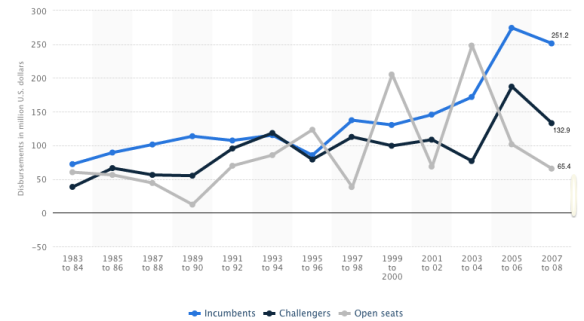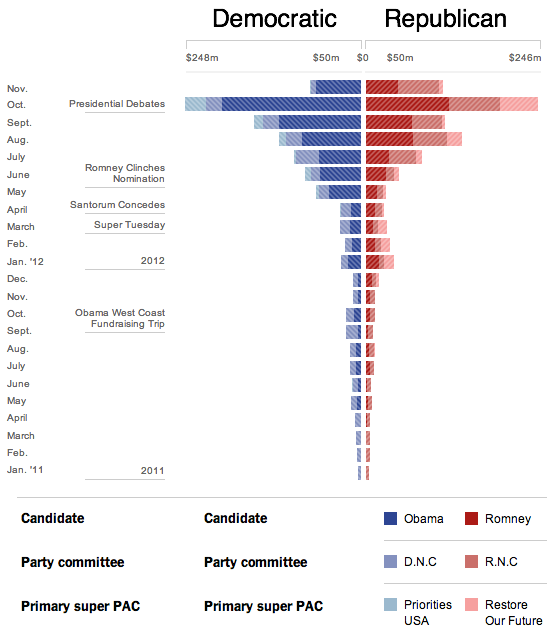What rules govern how campaign finances are spent? How and when are federal candidates (presidential and congressional), and independent groups spending their contributions?
In the United States Political System, the spenders in campaigns include the candidates themselves, PACs, parties and independent groups (including PACs). The rules that govern spending are perhaps the most controversial of all campaign financing legislature and cover three main points: who can spend, and when and how these separate entities can campaign.
One of the defining principles in campaign financing in the United States is that ‘contributions are limited, but spending is not’ (John Sides Campaigns & Elections – Chapter 4: ‘Financing Campaigns,’ page 98). This principle was established in Buckley v. Valeo in 1976. In this case, the Supreme Court upheld FECA’s limit on contributions based on the interest of preventing corruption, but struck down the limits on spending citing that it violated the free speech clause of the First Amendment to the Constitution.
As recently as 2002 with the passing of the Bipartisan Campaign Reform Act (BCRA) in 2002, Congress attempted to limit the spending of independent groups during federal elections. A provision of (BCRA) made it illegal to run ads that clearly supported a candidate or position up to 60 days before a general election and 30 days before a primary. However, this provision was struck down by the Citizens United v. Federal Election Commission in 2010.
The only instance in which spending can be limited is when presidential candidates accept public funding for their campaigns. Briefly touched on in the previous discussion topic, ‘ Fundraising Over Time and the Sources of Campaign Contributions’ (click here to view this page), presidential candidates during primary and general elections can choose to take public funding where the government matches the contributions raised, but requires the acceptance of a spending limit.
By not regulating spending, the United States Political system gives federal candidates and independent groups the incentive to raise and spend as much as possible. This has resulted in an increase in campaign spending over the course of the past 30 years. In 2012, the total spending of all presidential candidates, congressional (House and Senate) candidates, political parties, and independent groups totaled over $6.286 billion, up from $5.286 billion in the previous presidential election cycle in 2008.
Individually, presidential candidates have seen an exponential increase in disbursements/spending since the turn of the 21st century. Exhibit 1 (below) illustrates this increase. As you can see pending has increased from $343.49 million to $1,359.8 billion between the 2000 and 2012 elections.
Exhibit 1: Total Disbursements of Presidential Campaign Financing in the U.S. (1979-2012)
The increase in spending in presidential campaigns has been perpetuated by the combination of the lack of spending limits and the limits on contributions. By placing caps on the amount each individual can directly contribute to a presidential candidate’s campaign, the United States Political System increases the cost of campaigns as candidates must spend more funds on advertising to reach a larger number of potential donors. Because of this, advertising has been the largest expenditure for presidential campaigns for decades. Exhibit 2 (below) provides the breakdown of spending by presidential candidates for the 2012 election, where advertising ate up about 54.9% or $1.050 billion of total spending.
Exhibit 2: Breakdown of Presidential Candidates Spending in the 2012 Election
Congressional candidates share a similar breakdown of expenditure to presidential candidates. Overall expenditure tends to be for individual candidates because of the scale of a campaign for a House or Senate seat is much smaller than presidential campaigns. However, advertisement remains the largest portion of expenditure. Exhibit 3 (below) depicts growth of disbursements for U.S. congressional campaigns over the past 30 years.
Exhibit 3: Total Disbursements for U.S. Congressional Campaign Financing (1983-2012)
Notice, that total disbursement for House campaigns is much higher than that in the Senate. This is a result of the sheer number of individuals running for House seats compared to Senate seats. If the graph were to represent average disbursements for U.S congressional campaigns over the same time period, the House and Senate lines would be switched. Thus, the cost for an average seat in the Senate tends to be more than an average seat in the House.
Another interesting factor in congressional campaign expenditures is the effect of candidate status on the amount spent. Exhibits 4 and 5 (below) show several trends regarding the status of candidates. In general, for both House and Senate elections incumbents tend to have higher disbursements than challengers and candidates vying for an open seat. This can be contributed to the Incumbency Advantage, explained in the next discussion topic, ‘Campaign Financing and the Outcome of Campaigns’ (click here to view this page). Because incumbents are generally better known, they tend to raise more funds than challengers, thus are able to outspend their opponents in elections. Additionally, total expenditure for open seats tend to vary based on the competitiveness of the race and the profile of the candidates. More competitive races that have high profile candidates tend to have higher expenditures and vice versa.
Exhibit 4: Total Disbursements for U.S. Congressional Campaign Financing in the House of Representatives by Candidate Status (1983-2012)
Exhibit 5: Total Disbursements for U.S. Congressional Campaign Financing in the Senate by Candidate Status (1983-2012)
Similar to presidential and congressional candidates, independent group disbursements have increased gradually over the past two decades. According to Open Secrets, independent expenditures totaled over $1 billion in the 2012 presidential election, almost 7 times the amount spent in the 2008 election ($143.6 million). This increase in outside spending is a result of the Citizens United v. Federal Election Committee in 2012. As noted in the discussion topic ‘The Role of the Constitution, Congress and Supreme Court’ (click here to view this page), this decision led to the creation of Super PACs* or PACs that can raise and spend unlimited amounts on campaigns as long as they are not tied to a particular candidate. The 2012 election was the first with Super PACs and they sure made their presence know as source of outside spending in the 2012 election cycle. Because independent groups can’t directly work with a candidate, they tend to spend their contributions on mobilizing voters and advertising. Most advertising is more negative than ads created by specific candidates. An example of a Super PAC advertisement is below.
Video: Restore Our Future: ‘Mother’s Day’ Campaign Advertisement
As for when and where, candidates (presidential and congressional) and interest groups tend to focus their disbursements on times and places that are most critical for the election. For instance, Exhibit 6 (below), illustrates the monthly spending of the democratic and republican candidates, parties, and Super PACs in the 2012 election. Campaign spending tends to be the lowest during the year before the election and the highest during the four months leading up to election date (July, August, September, October). Both sides focus on this time in order to reach as many voters as possible to get their vote as well as to serve as a reminder to vote on election day.
Exhibit 6: Monthly Disbursements by Candidates, Political Parties and Primary Super PACs in the 2012 Election (January 2011 – November 2012)
Additionally, presidential elections tend to focus on battleground or swing states (such as Ohio and Florida) as November of election year draws closer. Swing states tend to decide close elections and have become increasingly important over the past few decades.
In conclusion, there are few laws that govern spending in federal campaigns. Across the board presidential candidates, congressional candidates, and independent groups have begun to spend more and more in an attempt to swing votes. All of these groups focus on critical points in place and time to increase expenditures. With the most recent Supreme Court ruling in McCutcheon v. Federal Election Committee (2014), described in the discussion topic ‘The Role of the Constitution, Congress and Supreme Court’ (click here to view this page), it is predicted that spending will continue to increase due to the elimination of aggregate contribution limits for individuals.
Note: For full list of citations, visit the Sources page.
* For more on Super PACs, visit the ‘Americans For A Better Tomorrow, Tomorrow: Breaking Down the Super PAC‘ sidebar.






